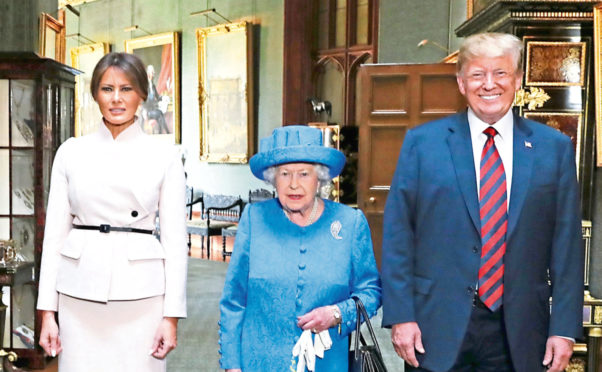
Donald Trump’s forthcoming state visit will be one of the most controversial we’ve ever witnessed.
The president is a hugely divisive figure and next month’s expected arrival will be a lightning rod for all sorts of issues.
And let’s face it, his last trip to these shores wasn’t exactly incident-free.
A state visit is a formal trip by a head of state, normally at the invitation of the Queen acting on the advice of her government.
Trump was promised one by Theresa May after his 2016 election but no date was set, and last year’s trip, during which he and the First Lady, Melania, met the Queen at Windsor Castle, was part of a lesser two-day “working visit”.
It sparked demonstrations across the UK, including the infamous Trump “baby blimp”, and the same campaigners have promised to mobilise huge numbers once again.
Also, many eyeballs were rolled when the president forgot protocol and royal etiquette and walked ahead of the Queen while inspecting her guards, maintaining a brisk pace that left the monarch trailing in his wake at times.
But it’s not as if Her Majesty’s a novice when it comes to hosting controversial characters.
In fact, she’s an old hand at it – having hosted 109 state visits since 1952 – and if anyone can steer her guest through his visit with the minimum of fuss, it’s the Queen.
In 1971, Japan’s wartime leader Emperor Hirohito was greeted by angry veterans and former prisoners of war who protested by standing in silence as he and the Queen passed them in an open carriage.
Thousands of protestors lined the route, some turned their backs on the emperor, some wore red gloves to symbolise those who’d died in the camps and others whistled the marching tune Colonel Bogey that featured in The Bridge On The River Kwai.
At the state banquet, the Queen said: “We cannot pretend that the past did not exist. We cannot pretend that the relations between our two peoples have always been peaceful and friendly.
“However, it is precisely this experience which should make us all the more determined never to let it happen again.”
Seven years later, when Romanian dictator Nicolae Ceausescu was making the first state visit by the head of a communist state, the Queen took more drastic action.
While walking her corgis in the palace gardens, she spotted the leader of what was known to be a corrupt and oppressive state and his wife heading in her direction – and decided the best course of action was hiding behind a bush to avoid forced polite conversation.
Ceausescu was honoured by the government during his visit in an attempt to improve relations during the Cold War but this knighthood was revoked after he was deposed in 1989.
President Vladimir Putin enjoyed the pomp and circumstance that always surrounds state visits but his trip in 2003, the first by a Russian leader since Tsar Nicholas I in 1843, sparked demonstrations by human rights activists against his actions in Chechnya.
No doubt Putin was pleased that US President George W Bush’s state visit five months later also saw thousands of demonstrators take to the streets, this time protesting against the Iraq War.


Enjoy the convenience of having The Sunday Post delivered as a digital ePaper straight to your smartphone, tablet or computer.
Subscribe for only £5.49 a month and enjoy all the benefits of the printed paper as a digital replica.
Subscribe